How to choose bathroom fixtures: which is better and why? Comparative review
Most bathrooms lack access to sunlight. We have to rely solely on artificial lighting. To ensure optimal luminous flux, it is necessary to correctly select fixtures for the bathroom, right?
We will help you find the perfect device for you and plan its location. We’ll show you which option will work flawlessly in difficult operating conditions. We will tell you how to determine the power of the installed lamps and which way to organize lighting to give preference.
The tips given in the article are backed up with video guides and photo materials with valuable tips and original ideas for decorating the bathroom.
The content of the article:
Technical requirements for fixtures
Bathroom - an area with extreme operating conditions. In places with constant temperature changes and high humidity, installation of ordinary outlets and lamps is prohibited for safety reasons.
The main parameter for choosing a lighting device is the degree of security. Corresponding marking is displayed on the body of electrical products.
Some manufacturers use three-digit markings. The third figure is the degree of susceptibility to mechanical damage, shock. The range of values is 0-10. The highest level of protection indicates that if the enclosure is damaged, the performance of the appliance is maintained.

The higher the numerical marking indicator, the more reliable the lamp.
Moisture-proof devices are equipped with additional elements that reduce the risk of water and dust penetrating the conductive sections of the device:
- rubber seals on the ceiling;
- sealing plugs on the lead wire.
The minimum IP value for fixtures in wet rooms is IP442, and the maximum is IP674. It is permissible to use products with protection above the maximum - increased safety, in any case, is welcome.
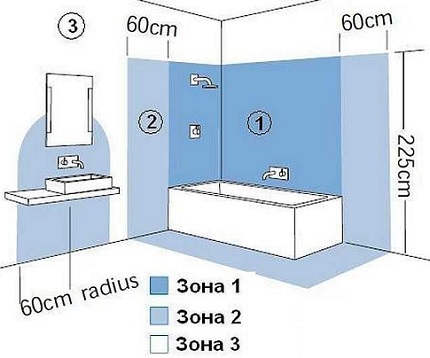
IP index values for each zone:
- First zone. Humidity around the bowl of the bathtub, shower and washbasin reaches 100%. Here, it is permissible to install low-voltage devices with at least IP67 protection, designed for temporary immersion in water.
- Second zone. Within a radius of 30-60 cm from the “wet” zone, there is a high probability of splashes and jets getting onto the appliance. It is not advisable to use high-voltage electrical appliances on the site, the lamp protection rating is not lower than IP45, the power is 12-24 V.
- The third zone. Relatively safe - 60 cm from the borders of the second zone. There is virtually no risk of direct jets. Circular splash protection models are installed - IP24 and higher.
A space at a distance of 3 m or more relative to the water source is considered safe. Installation of luminaires with IP01 is possible here.
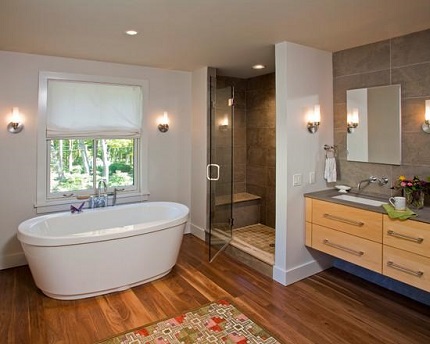
The variety of fixtures of the "marine elite"
The artificial lighting of the bathroom is conditionally divided into three levels: ceiling, wall and floor. The combination of methods will provide an interesting decorative effect. It is not necessary to use the entire spectrum at the same time. The main thing is to get a full luminous flux for a comfortable stay in the room.
No. 1 - options for ceiling lighting
Ceiling lights provide basic bathroom lighting. The choice of device depends on the size of the room, the design of the ceiling and the availability of secondary light sources.
Popular highlighter solutions:
- mounted or suspended ceiling;
- LED Strip Light;
- light panel;
- spots;
- spot lights for suspended or suspended ceilings.
Traditional chandelier. This option is more suitable for spacious bathrooms with a high ceiling. The main advantages of the solution: a diverse range and ease of installation. The determining criterion for choosing a chandelier is whether the appliance matches the interior of the bathroom.
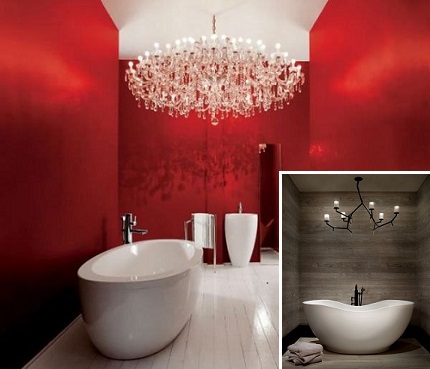
An alternative to crystal is glass and metal models. Pros: affordable cost and various styles of fixtures for the bathroom. Less - the appearance of spots and drips from the water.
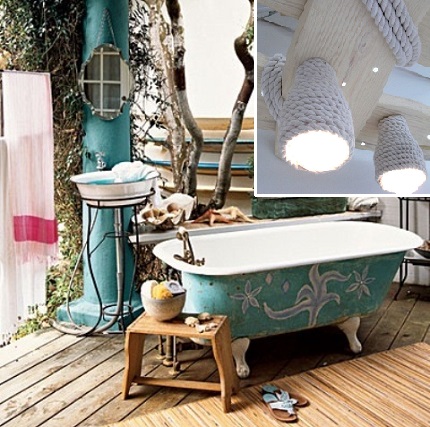
LED Strip Light. LED backlighting is presented in the form of LEDs and resistors fixed to a cool ribbon-based. Moisture-proof tapes with the IP65-68 index are developed for "wet" zones of the room.
The luminous strip with IP65 is sealed on one side - the insulation covers the outside of the circuit board, including LEDs and contacts.
Backlight Benefits:
- ease of installation - the tape is placed under the ceiling;
- the ability to adjust the intensity of lighting;
- variety of glow colors - you can make a smooth transition in a given spectrum.
To create a "tape" ceiling area lights Suitable LED strip with IP65 and IP67.
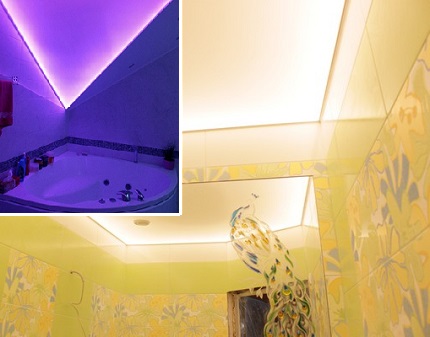
Light panel. This is not just a separate lamp, but a special ceiling structure consisting of individual elements:
- lamps mounted directly on the ceiling;
- decorative plastic or glass panel that covers the lights;
- frame with guides for fixing the panel.
The main advantage is an unlimited choice of design. Using photo printing, you can recreate any picture: the starry sky, the underwater world, a picturesque landscape, etc.
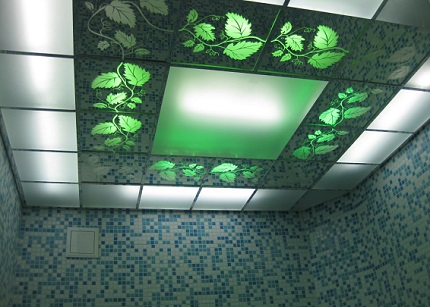
Spots. Laid on "flashlight", where more than one lamp is installed on one holder. Despite an interesting idea, spots are rarely used for ceiling lighting.
Firstly, the product looks bulky in a bathroom with low ceilings, and secondly, it is problematic to adjust the light flux vector.
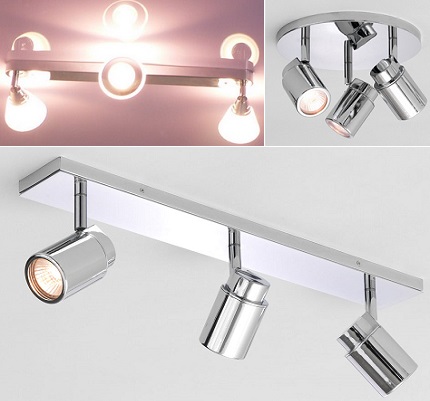
Spotlights. This type of electrical appliances indispensable for the installation of suspended or "French" ceiling. The arrangement of fixtures is thought out in advance, taking into account the zoning of the room and the power of the lamps.
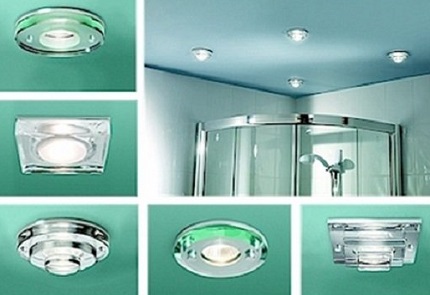
Depending on the design features, the following types of spotlights are distinguished:
- built-in;
- half-cut;
- waybills;
- sectional.
Tips for choosing bulbs for installation in spotlights given hereWe recommend that you familiarize yourself with useful information.
Embedded. Devices are used for hidden installation - only the ceiling is visible. When choosing, it is necessary to take into account the "depth" and the width of the ceiling space. The minimum length of the “legs” of the mortise lamp is 40 mm.
Some models require a significant reduction in the suspension design, which is undesirable to do with low ceilings and limited room dimensions.

Half-cut. The technical “body” of the luminaire is located behind the ceiling, and the bulb is outside. Ceiling space is used for installation, however, due to an external ceiling, the installation of more powerful lamps is permissible.
Overhead. Outdoor installation is applicable for most types of ceilings. Overhead lamps are more expensive than mortise models, but have a number of significant advantages:
- there is no need to lower the ceiling level;
- universality;
- decorative effect of light scattering through the prism of textured glass.
Impressive design of the base of the lamp. On the ceiling surface mirrored, shiny materials and metals encrusted with stones look spectacular.
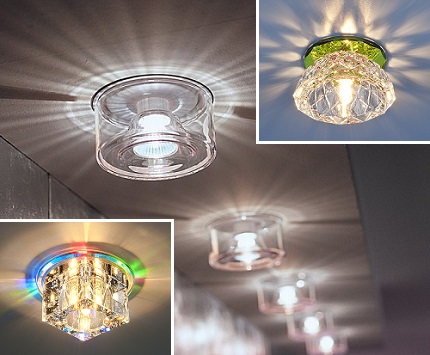
Sectional. This is a kind of hybrid of spots and spotlights. A single decorative plate contains several lamps. As a rule, for each micro-luminaire, a lighting vector can be set.
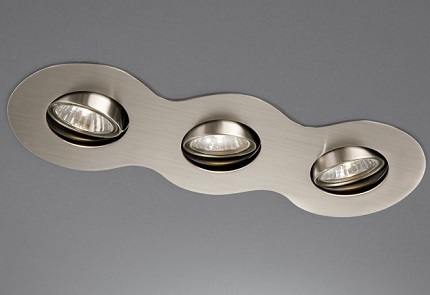
No. 2 - working lighting with wall models
The purpose of wall lights is the zoning of the room and local lighting.The use of wall "lights" is appropriate in spacious rooms with an area of 6 sq.m. In a compact room you can limit yourself to ceiling lighting.
Popular options for wall "water" lamps:
- sconce;
- illuminators for surface mounting;
- spots.
Sconce. The traditional design is one or more shades mounted on one bracket.

Overhead lights. The compact ceiling does not take up much space and is fixed to the wall. It is better to choose models made of moisture-resistant materials: stainless steel in tandem with glass and transparent plastic.
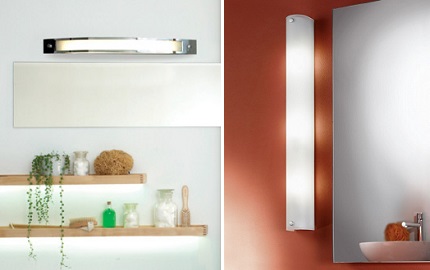
Spots. Wall installation allows you to maximize the purpose of spots - local lighting.
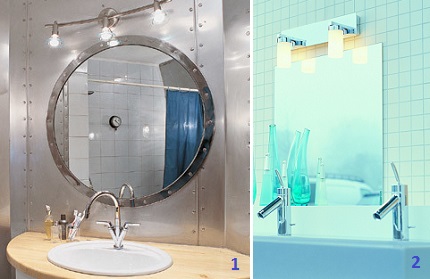
In the second case, the light from the spot will blind your eyes - using a mirror will become uncomfortable. For this zone, you should not choose lamps with colored shades - the backlight "will give" an unnatural complexion and hair color. Optimum - frosted or white glass.
It is worth paying attention to the type of light beam of the wall "lantern". There are two varieties:
- Directional Reflectors. Light is supplied at a certain angle. Perhaps one or two sided (up / down) light flux vector. The shape of the case allows you to concentrate the backlight in a specific area.
- Diffused light shades. Such models belong to general lighting fixtures, their area of "action" is 360 °. Light is scattered in the room evenly.
If the goal is to create not only practical, but also spectacular lighting, you can interestingly beat the walls with the help of spotlights, a bright light panel, linear led bulbs or LED strip.

No. 3 - decorative floor lighting
Floor lighting embodies a special atmosphere in the bathroom. This background, decorative light.
To implement the design idea using different methods:
- installation of LED backlight;
- installation of spotlights;
- creating a glass floor;
- the use of luminous tiles;
- arrangement of the bulk base.
Neon lights. There are many options for decorating LED strip. The strip is mounted along the skirting line - the perimeter of the room, and also used to highlight plumbing - a sealed tape "passes" along the contour of the bathtub or washbasin.
The main plus of the method is the ability to install after the repair. In contrast to the dark floor, glowing specks look spectacular.
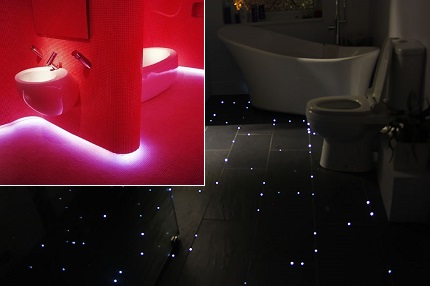
Spotlights. The use of floor spot lights has its own characteristics.
The advantages of lamps include:
- resistance to mechanical damage - shades are made of durable plastic;
- the possibility of any location - the distance between the lamps is chosen arbitrarily;
- creating beautiful highlights on surrounding objects.
The disadvantages of “points of light”: the complexity of installation and summing of hidden wiring, the need for periodic replacement of bulbs.
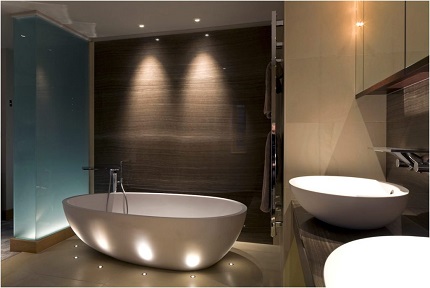
Glass floor. Exquisite design technique dramatically changes the look of the familiar bathroom. To equip a glass niche, you will have to raise the floor by 10 cm.
An unusual “lamp” is made of tempered laminated glass or triplex; LED strip or linear lamps are suitable for lighting.

Luminescent materials. An alternative to traditional methods of illumination is finishing materials with a luminous effect. The plus of the method is independence from electricity. Cons: the high cost and the inability to turn off such a "lamp."
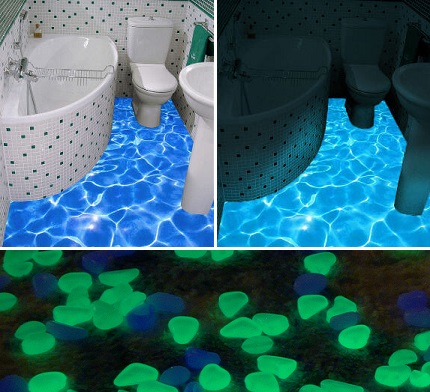
Choosing a lamp for a "water" lamp
Pondering which lamp is better to choose for the bathroom and how ideal organize lighting, It is important to determine the type of lamp, brightness and optimal lighting tone.
Criterion # 1 - optimal product performance
In everyday life, the most popular are traditional incandescent lamps, fluorescent products and LEDs.
Incandescent lamps. Depending on the gas composition inside the container, they are vacuum, krypton and halogen. Inert gas lamps (krypton) are resistant to power surges, halogen ones have good light output and last longer.
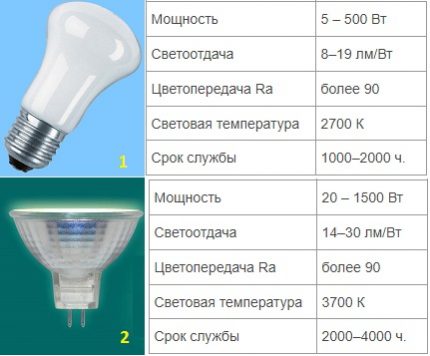
Fluorescent lamps. The so-called fluorescent lamps have varying degrees of color rendering, which determines the naturalness of the glow.
The main advantages of fluorescent lamps:
- low heating temperature;
- duration of work;
- soft light.
Modern modifications are suitable for connection to a standard lamp holder. Types and marking of socles for lamps installed in currently used lighting devices, are listed here. This information is useful to a potential buyer.

LED products. The high cost of the lamp is justified by low power consumption, good light output and long life. Additional advantages include: compactness, low bulb heating, resistance to mechanical stress and power outages.
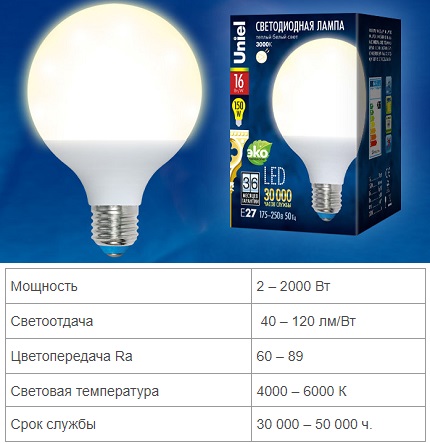
Criterion # 2 - calculation of the luminous power
The international standard ISO8995 regulates the level of illumination of bathrooms. The recommended rate is 200 suites (Lx). To characterize the light output of the lamps, lumens (Lm) are used, 1 Lx = 1 Lm / sq.m.
For example, the normal illumination of a room of 7 square meters is 1400 Lux, 10 square meters - 2000 Lux, respectively. Based on the calculated data, the power and the number of lamps are selected.
The degree of light output directly depends on the type and power of the lighting device. For example, at the same power, a luminescent product produces 7 times more light than an incandescent lamp. WITH LED lamp specifications Introduces the article, which we recommend that you read.
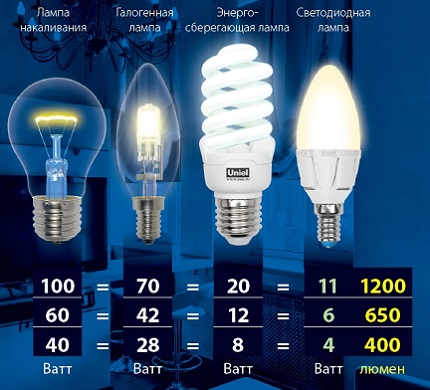
Criterion # 3 - color rendering index and lighting tone
The comfort of light perception depends on how natural the surrounding objects look under artificial lighting. The parameter is expressed by the color rendering coefficient and is indicated on the packaging of the lighting device - Ra or CRI.
Light source CRI = 100 provides a real display of objects. The maximum color rendering index has natural sunlight. The lower the indicator Ra, the more distorted the perception.
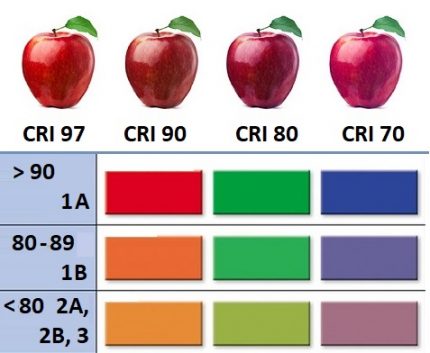
The hue of the illuminated object is determined color temperatureThe unit of measurement is Kelvin (K). White plumbing may appear yellowish or radiant blue.
When choosing a color, one should proceed from the prevailing tones in the interior and personal preferences.
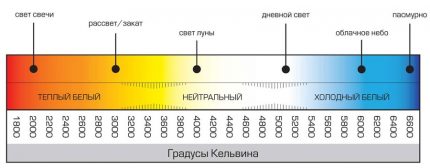
Glow of different temperatures affects a person differently. A warm white tone helps to relax, a neutral one helps to concentrate, a cold tone energizes and invigorates.
Introduces the overview and selection criteria for energy-saving lamps next articlefully dedicated to this interesting subject.
Conclusions and useful video on the topic
The video describes the main factors for choosing an electrical appliance, the requirements for fixtures for rooms with a high level of humidity, and also gives recommendations on zoning the space using lighting:
The competent choice of the lamp and the successful arrangement of light accents can visually increase the enclosed space of the bathroom. Equally important in arranging a comfortable and practical room will play a selection of brightness, color reproduction and shade of the lamp.
Please leave comments in the box below. Share important for you personally guidelines for choosing a waterproof lamp and information that will be useful to visitors to the site. Ask questions, describe your experience in installation, publish photos on the topic of the article.

 Lamps for suspended ceilings: types, how to choose the best + brand overview
Lamps for suspended ceilings: types, how to choose the best + brand overview  Lamps over the bed: TOP-10 popular offers and tips for choosing the best
Lamps over the bed: TOP-10 popular offers and tips for choosing the best  UV lamp for home use: types, how to choose which manufacturer is better
UV lamp for home use: types, how to choose which manufacturer is better 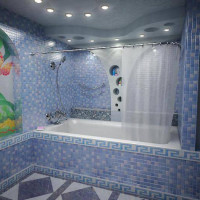 Lamps in the bathroom on the ceiling: types, placement principles, installation nuances
Lamps in the bathroom on the ceiling: types, placement principles, installation nuances 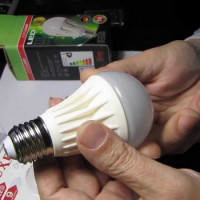 Which LED lamps are better to choose: types, characteristics, choice + best models
Which LED lamps are better to choose: types, characteristics, choice + best models  Choosing energy-saving lamps: a comparative overview of 3 types of energy-efficient light bulbs
Choosing energy-saving lamps: a comparative overview of 3 types of energy-efficient light bulbs  How much does it cost to connect gas to a private house: the price of organizing gas supply
How much does it cost to connect gas to a private house: the price of organizing gas supply  The best washing machines with dryer: model rating and customer tips
The best washing machines with dryer: model rating and customer tips  What is the color temperature of light and the nuances of choosing the temperature of the lamps to suit your needs
What is the color temperature of light and the nuances of choosing the temperature of the lamps to suit your needs  Replacement of a geyser in an apartment: replacement paperwork + basic norms and requirements
Replacement of a geyser in an apartment: replacement paperwork + basic norms and requirements
Lighting and bathroom design is limited only by your imagination. A variety of lighting devices allows you to turn your bathroom into a fabulous corner. The only thing is that in stores it is quite difficult to find a lighting device with an appropriate degree of protection, which you need to pay attention to first of all. Therefore, always consult with service personnel and see product documents.
It is clear that a lot depends on the design, but still we must not forget that the lamps, if they do not have special protection, should not be in the zone of possible water ingress. I also consider it very important not only to chase the appearance, but also not to forget about the functionality.After all, it is often in the bathroom that one has to shave and bring his appearance back to normal.
A traditional chandelier is of course the most aesthetic and practical option, but our ceilings are not suitable for its installation. We have a usual suspended ceiling, and it is mounted on the wall, and not on the ceiling. When we drove into a new apartment, we got it from the builders. I plan to change to something more attractive and modern. Tape lights look very cool, spotlights also like.
Maybe a traditional chandelier and an aesthetic option, but definitely not the most practical, especially for a bathroom. Even if you are not going to pour water onto your ceiling, your neighbors can always do this from above. And in any case, the humidity in the bathroom will be high.
Thank you for the article. The information is detailed and very valuable. The choice of solutions is huge, limited only by the imagination of the designer.